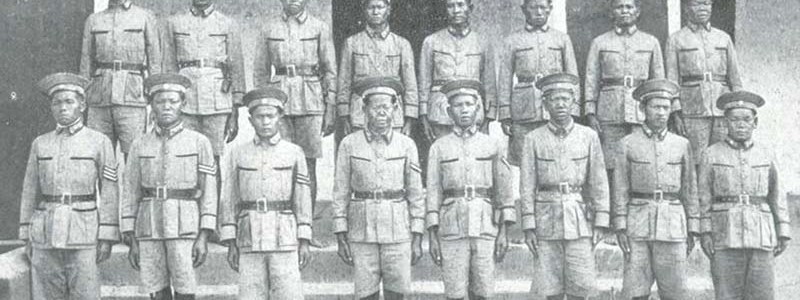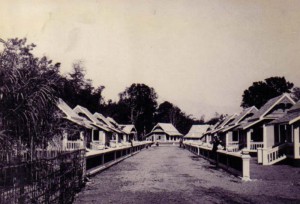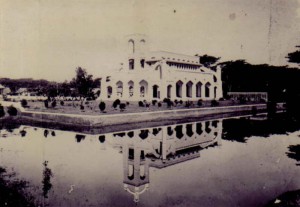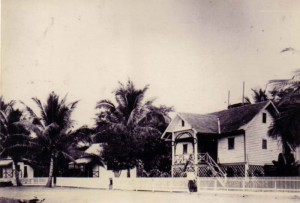
Chiang Mai (Thailand)

Buildings at Chiangmai Leprosy Colony. (Source: McKean Rehabilitation Center)
Dr James McKean founded the “Chiangmai Leper Asylum” in 1908, assisted by Pauliang Chantah Indravude. It was the first leprosy centre in Thailand, at a time when leprosy sufferers were usually rejected from home and community. Many had wandered until they came to beg the township in order to survive. They would live together in small groups, finding shelter wherever they could. They also went regularly to the mission clinic for food and some basic medical attention. Although there was no effective treatment for the disease, James McKean asked permission of the local ruler to set up a centre for people to have somewhere to live. Subsequently, he constructed small cottages in village groupings, a clinic, a water tower and a church. Women were housed in a separate “village” at the northern end of the area, and the men were at the other end, in the men’s village. Both “villages” were in a community with provisions for basic necessities, as well as spiritual and medical support. Hospital wards, a school and more cottages were built gradually over the next 20 years to house people from all over Thailand, and even from neighbouring countries. Responsible patients were put into teams (maintenance, guards, nurses) to help run the center.
A history of the changes that have taken place at Chiang Mai has been provided by Dr Trevor Smith (McKean Rehab Center, Chiangmai, Nth Thailand)
An account of the events surrounding the leprosarium, and especially the involvement of the McKeans, can be found in the chapter by T R Brown in Contagious Compassion: Celebrating 100 Years of American Leprosy Missions. Providence House: Franklin, 2006, pp. 25-42. The following account has been extracted from Ted Brown’s chapter.
In 1903, between 50-150 leprosy victims were encamped on an island in the Ping River one mile south of Chiang Mai. Under unknown circumstances, they were driven from the island and left homeless in 1905. Late in 1905, Dr J W McKean, who had previously provided medical care for these islanders, gained permission from the Minister of the Interior of Siam, the High Commissioner of Chiang Mai, and the Prince of Chiang Mai, to establish a leprosy home on another nearby island. The Mission was granted 164 acres on the southern half of Koh Klang (“Middle Island”). This was the first time that the government had ever set aside land for people with leprosy.
A clearing was made on the island and bamboo huts were built. In 1908, seven leprosy victims and two children moved to the island. At the beginning of 1909, there were eight persons and, by the end of the year, there were fifteen, despite two deaths. By 1910, their number had grown to twenty. By the time the leprosarium was officially opened on June 11, 1913, it held 100 resident patients.
By 1914 four more buildings had been added, with 16 beds in each. The growth of the settlement (in terms of the absolute number of patients) peaked in 1914 and 1915 when an average of 30 residents were added each year. This was followed by a deceleration of growth which lasted for about six years. High attrition rates seem to have been the reason for the slowdown.

Chiangmai Leprosy Colony. (Source: McKean Rehabilitation Center)
Chaulmoogra oil treatment was introduced at this time and some were discharged, apparently restored to good health. The Mission reported, “Their improved physical condition begets the desire to get out and begin life again is what accounts for the large number of runaways.” However, cures were rare. Only a small fraction (2 of 30 in 1917) were cured when they left. The others probably left from discontent. The discomfort caused by painful chaulmoogra injections was unlikely to be a factor, since this was entirely voluntary. Dr McKean attributed the number of runaways to the monotony of life in the asylum and also overcrowding. For example, in January 1916, 178 patients were housed in rooms sufficient to cater for only 130 patients. Two years later many were being housed in bamboo huts because the permanent structures were full.
The new women’s dormitory was built in around 1917 and officially opened in 1919 at a cost of 2,000 US Dollars. The structure could accommodate 30 women in five rooms. There also 15 small cottages, each housing a few women. Wooden or brick and mortar cottages built in the 1910’s and early 1920’s were offered as alternatives to the dormitories for those who could be independent. At some stage, a temporary school was built at the north end of the athletic field for children. This had 32 pupils in 1922. A second school was opened for the healthy offspring of leprosy patients, local children and the offspring of non-leprous asylum staff.
From 1909 to 1917, the main overseas financial contributor had been The Leprosy Mission. From 1917 until World War II, the main supporting agency was the American Auxiliary of the Mission to Lepers. These two organizations provided a major part of the funding for buildings and maintenance. In 1919, the Thai Government also provided 10,000 baht, which became an annual gift in the 1920’s and 1930’s.
On March 11, 1927, the Hays Memorial Clinic/ Infirmary was added to the other buildings on the island. It had no more than a dozen beds, but allowed the sick men and women to be gathered together for treatment. This became the headquarters for the medical staff, pharmacy and chaulmoogra injections. The missionary doctors (Cort and McKean) began to hold three regular clinics there a week. Improved medical care and better housing probably combined to bring down the death rate. In 1927, this was 6% and in 1930, 4-5%. These were significant improvements over the first year of operation when the death rate had been 14%.

Chiangmai Leprosy Colony. (Source: McKean Rehabilitation Center)
During the depression years, with financial support from America, Dr McKean and his son, Hugh, who succeeded him as director, encouraged patients to resettle into communities or leprosy villages scattered throughout the north of Thailand. The Center could no longer afford to provide free food and care for the numbers that had sought refuge there, and some patients wanted to return to family life. Trusted patients, often trained in the McKean Bible school, were trained in medical care and were sent out to areas of north Thailand where there were known concentrations of leprosy patients to work in clinics on land bought by McKean. These workers provided treatment, shared their faith, and acted as a liaison with McKean, whose staff visited periodically, enabling transfer of patients to the hospital if necessary. Patients moved out to live around the clinics, which were also becoming churches. With new arrivals, McKean bought more land. Some 25 such villages were formed, ranging from 10 to 120 patients. Social intercourse with other villages occurred warily at first, but gradually increased aided by medical, agricultural and educational development support provided from the Centre. McKean workers helped as advocates, when necessary, in villages to access local services as they came into existence.
Segregated patient care had been the policy thus far, and was provided at the Centre, and in the resettlement villages. But with the advent of DDS, the possibility of treatment and cure from the disease became a reality, even though therapy was advocated as needing to be lifelong. Patients still at the Centre (now renamed McKean Leprosy Hospital, from 1949) began to improve and some were able to go home. However, stigma and fear prevailed in the attitudes of many and the number of residents at the Hospital steadily increased, reaching a peak of just over 1000 by 1969. Some more resettlement villages were formed during these years, mainly brought on by a policy dispute amongst some of the leaders of the work. There was improvement in the quality of life for the patients, with spiritual nurture and useful employment being provided. Various vocational activities helped. Many patients became very skilful in handcrafts and agricultural projects. Other more disabled workers lived and worked at McKean in various types of sheltered workshops, producing woodcarvings, lacquerware, sewing and embroidery items, or involved in a McKean vocational training centre for furniture making and printing.

Chiangmai Leprosy Colony. (Source: McKean Rehabilitation Center)
Starting in 1967, the first of a series of skin clinics was established throughout the north of Thailand, with the purpose of detecting early cases of leprosy, and providing a more convenient and non-stigmatizing place for patients to obtain treatment closer to their homes. In 1972, it became the official Thai Government policy to integrate leprosy into their public health stations and hospitals, and the government officially took over the leprosy control work. This meant that McKean’s outpost clinics were no longer so necessary in all areas. (However, two of these clinics are still functioning as leprosy patients are still being detected at them, and they are seeing so many other dermatological cases that they help to subsidize the income for the main Centre). Reconstructive surgery had commenced at the Hospital in 1967, and outpatient supervision of care became popular as many people were no longer being forced to a life of isolation and rejection. At these clinics, many surgical needs were also being encountered (especially thyroid goitres), and as the waiting list at the main government teaching hospital was so long, many patients consented to having surgery at McKean. The reputation for reconstructive surgery (burns contractures, congenital deformities, cleft lips and palates) also attracted clients, and a steady stream of non-leprosy surgery provided a challenge for the rehabilitation staff. This had real benefits for the leprosy program, as patients who had earlier felt much self-pity now realised that others were worse off than they were. This was even more evident when the first genuine rehabilitation spinal injury patients were admitted in 1987.
By 2003, Trevor Smith writes that ironically, the original situation of unwanted leprosy patients gathering under the Chiangmai bridge by night, and begging by day has re-appeared. The present group are Burmese refugees, illegally in Thailand, in order to beg in affluent areas. This group has learned that treatment is available in McKean, and they are coming. Their illegal status means they avoid any official treatment with the integrated health services for registered Thai nationals. With the deployment of former experienced government leprosy control workers, the task of diagnosis and treatment falls on district hospital workers, who may have minimal leprosy understanding. McKean’s role has returned to one of training in cooperation with public health leadership. McKean is now part of the government “Health for all” programme – providing total care for the local district population as a general hospital, and referring on to the university hospital those for whom we cannot provide expert services needed. The local people are now coming to McKean for general outpatient and inpatient care, and emergency treatment. This has led to further integration, and has involved us in more public health activities – health promotion, vaccinations, and screening of the population for preventable diseases.
McKean Hospital & Leper Colony Chiang Mai on scooter.
Sources
T R Brown in Contagious Compassion: Celebrating 100 Years of American Leprosy Missions. Providence House: Franklin, 2006, pp. 25-42.
Dr Trevor Smith (McKean Rehab Center, Chiangmai, Nth Thailand)
